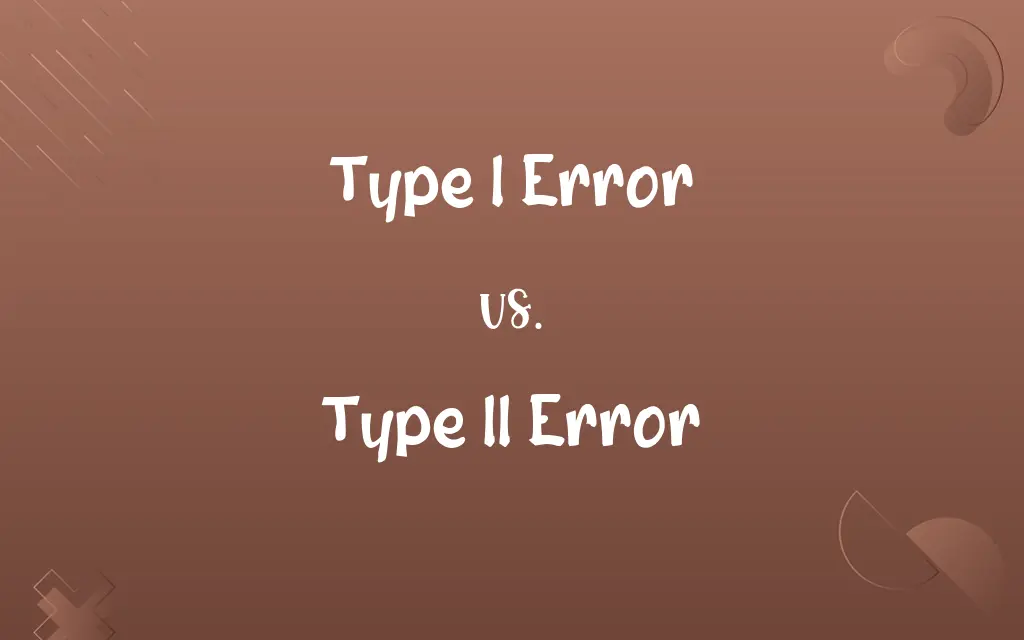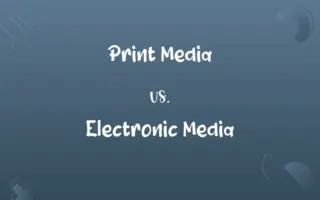Type I Error vs. Type II Error: Know the Difference

By Shumaila Saeed || Published on January 19, 2024
Type I Error is falsely rejecting a true null hypothesis, while Type II Error is failing to reject a false null hypothesis.

Key Differences
Type I Error occurs when a true null hypothesis is incorrectly rejected, often called a "false positive." It represents an error of overestimation or seeing an effect that is not there. Type II Error, on the other hand, happens when a researcher fails to reject a false null hypothesis, known as a "false negative," implying an error of underestimation or missing an existing effect.
Shumaila Saeed
Jan 19, 2024
In the context of hypothesis testing, Type I Error reflects the risk of concluding that a difference exists when, in reality, there isn’t one. This can occur, for example, in clinical trials when a drug is deemed effective but is not. Conversely, Type II Error involves concluding there is no effect when there actually is one, like missing the effectiveness of a drug that truly works.
Shumaila Saeed
Jan 19, 2024
The probability of making a Type I Error in a statistical test is denoted by the alpha level (α), typically set at 0.05. This signifies a 5% risk of wrongly rejecting the null hypothesis. Type II Error is represented by beta (β), and the power of a test (1-β) is the likelihood of correctly detecting an effect, with higher power reducing the risk of a Type II Error.
Shumaila Saeed
Jan 19, 2024
Type I Error is more critical in situations where the consequences of a false alarm are severe, such as in criminal justice or safety critical systems. In contrast, Type II Error is of greater concern in fields like medical research, where failing to detect a true effect (like the efficacy of a new treatment) can have serious implications.
Shumaila Saeed
Jan 19, 2024
Reducing Type I Error typically involves setting more stringent criteria for rejecting the null hypothesis, which can simultaneously increase the risk of Type II Error. Therefore, a balance between these errors is essential in research design, considering the implications of both false positives and false negatives.
Shumaila Saeed
Jan 19, 2024
ADVERTISEMENT
Comparison Chart
Definition
Incorrectly rejecting a true null hypothesis.
Failing to reject a false null hypothesis.
Shumaila Saeed
Jan 19, 2024
Concern
More critical where false alarms are costly.
More critical where missing an effect is costly.
Shumaila Saeed
Jan 19, 2024
ADVERTISEMENT
Type I Error and Type II Error Definitions
Type I Error
Incorrectly rejecting the null hypothesis.
A jury convicting an innocent person demonstrates a Type I Error.
Shumaila Saeed
Jan 07, 2024
Type II Error
Overlooking a real difference or change.
Not noticing a significant improvement in patient health due to a new treatment is a Type II Error.
Shumaila Saeed
Jan 07, 2024
Type I Error
False alarm or error of commission.
An alarm system signaling a break-in when there's none is a Type I Error.
Shumaila Saeed
Jan 07, 2024
Type II Error
Failing to detect an actual effect.
Overlooking the effectiveness of a new medication is a Type II Error.
Shumaila Saeed
Jan 07, 2024
Type I Error
Erroneous confirmation of an experimental hypothesis.
A scientist erroneously confirming a non-existent link between two variables commits a Type I Error.
Shumaila Saeed
Jan 07, 2024
ADVERTISEMENT
Type II Error
Erroneously accepting the null hypothesis.
A jury acquitting a guilty person illustrates a Type II Error.
Shumaila Saeed
Jan 07, 2024
Type I Error
Mistakenly detecting a difference or change.
Finding a statistical significance in identical twins' test scores due to random chance is a Type I Error.
Shumaila Saeed
Jan 07, 2024
Type II Error
Failure to establish a significant experimental hypothesis.
A scientist not recognizing a true relationship between two variables commits a Type II Error.
Shumaila Saeed
Jan 07, 2024
Type I Error
Falsely identifying an effect when none exists.
Declaring a new drug effective based on flawed test results is a Type I Error.
Shumaila Saeed
Jan 07, 2024
Type II Error
Missed alarm or error of omission.
An alarm system not activating during an actual break-in is a Type II Error.
Shumaila Saeed
Jan 07, 2024
Repeatedly Asked Queries
Can Type I Error be completely eliminated?
No, but it can be minimized through rigorous testing and validation.
Shumaila Saeed
Jan 19, 2024
How can one reduce the risk of Type I Error?
By setting a lower alpha level, like 0.01 instead of 0.05.
Shumaila Saeed
Jan 19, 2024
What is a Type I Error?
It's the incorrect rejection of a true null hypothesis (false positive).
Shumaila Saeed
Jan 19, 2024
What causes a Type I Error?
It's caused by random chance or flawed experimental design.
Shumaila Saeed
Jan 19, 2024
Is Type I Error related to the sample size?
No, it's related to the alpha level, not directly to sample size.
Shumaila Saeed
Jan 19, 2024
What leads to a Type II Error?
Insufficient sample size, low variability, or poor study design.
Shumaila Saeed
Jan 19, 2024
What does a high beta level indicate?
A higher risk of committing a Type II Error.
Shumaila Saeed
Jan 19, 2024
How is Type II Error minimized?
By increasing the sample size or power of the test.
Shumaila Saeed
Jan 19, 2024
Does a lower Type I Error risk increase Type II Error risk?
Yes, there's often a trade-off between reducing these two errors.
Shumaila Saeed
Jan 19, 2024
Is Type II Error related to false negatives?
Yes, it’s about failing to detect a real effect.
Shumaila Saeed
Jan 19, 2024
How do sample characteristics affect these errors?
Sample size, variability, and selection bias can impact both errors.
Shumaila Saeed
Jan 19, 2024
What is a Type II Error?
It's the failure to reject a false null hypothesis (false negative).
Shumaila Saeed
Jan 19, 2024
Can both Type I and Type II Errors occur simultaneously?
Not in the same test; they are mutually exclusive outcomes.
Shumaila Saeed
Jan 19, 2024
Is Type I Error more about false positives?
Yes, it’s about incorrectly finding an effect.
Shumaila Saeed
Jan 19, 2024
Can peer review reduce these errors in research?
Peer review can identify potential errors in study design and analysis.
Shumaila Saeed
Jan 19, 2024
How does test power relate to Type II Error?
Higher test power (1-β) reduces the risk of Type II Error.
Shumaila Saeed
Jan 19, 2024
Can changing the hypothesis affect these errors?
Yes, a more specific hypothesis can impact the error rates.
Shumaila Saeed
Jan 19, 2024
Are these errors relevant in non-statistical contexts?
While they originate in statistics, the concepts are broadly applicable.
Shumaila Saeed
Jan 19, 2024
Which is more serious, Type I or Type II Error?
It depends on the context and consequences of the error.
Shumaila Saeed
Jan 19, 2024
How is Type I Error represented statistically?
By the alpha level (α), such as 0.05 or 5%.
Shumaila Saeed
Jan 19, 2024
Share this page
Link for your blog / website
HTML
Link to share via messenger
About Author
Written by
Shumaila SaeedShumaila Saeed, an expert content creator with 6 years of experience, specializes in distilling complex topics into easily digestible comparisons, shining a light on the nuances that both inform and educate readers with clarity and accuracy.









































































